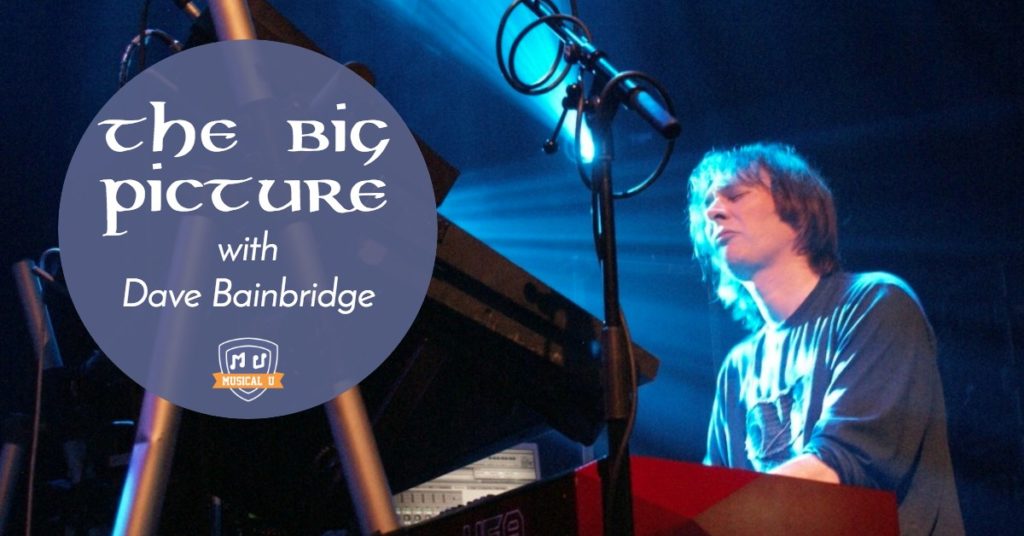Well known for his 13 acclaimed albums with the UK-based prog-rock/ambient/Celtic band Iona and numerous other group and solo projects, Dave Bainbridge has spent decades in the studio, as a composer and co-creator of original music of symphonic scope. Last time we spoke with Dave, we learned about his roots in the blues, his love for Celtic music, and passion for instruments. We then spoke with him about how he composes big-picture musical works and the role of technology in that process:
Q: Greetings Dave, and welcome back to Musical U! You’ve been recording your own music for decades. How has technology changed the process?
There are so many possible variables today when writing – an almost infinite palette of keyboard sounds and sample libraries covering just about every type of instrument and style. This can all be a bit bewildering!
Ironically, when I look back at the music I listened to in my formative years, I see a lot more variety in the styles and sounds of the 1970s (even though the resources were so much more limited) than I hear in much contemporary music – especially in the rock and progressive genres.
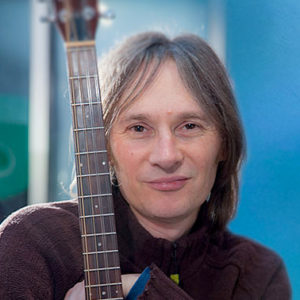 How could that be? Well when you have a more limited palette of sounds available, you’re forced to be more creative and focused in how you use them. Every sound really counts in a way that if you’re faced with an infinite variety, they don’t.
How could that be? Well when you have a more limited palette of sounds available, you’re forced to be more creative and focused in how you use them. Every sound really counts in a way that if you’re faced with an infinite variety, they don’t.
It’s the same with present-day DAWs (Digital Audio Workstations) like ProTools and Logic etc. When I started off recording my own music, we were recording to tape and would be limited by how many physical tracks could fit onto that tape. My early demos were recorded in 8 or 16 track studios, so you had to be very economical in choosing which sounds and musical parts worked together.
Now I’m recording on powerful computers where you can have an almost unlimited number of tracks and therefore musical parts, so that’s not an issue anymore. But the problem now is that you can defer making decisions about which parts you’re going to use, and you can also end up recording so many parts that you lose clarity within your music.
Q: How do you manage that abundance of possibilities?
Whenever I start writing a new album – even before I’ve even composed anything – I start writing general notes. What I want the album to sound like. What sound combinations I want to use (which acoustic instruments, what kind of electronic sounds etc). Whether I want vocal textures, lyrics. Whether there will be improvised sections and/or scored out sections. Who will be the best musicians to interpret the style of music.
I often find inspiration in things I read or experience, or other events happening in the world. So I’ll also collect all these together and periodically read through them to see if any resonate with the current project.
All the while my aim is to whittle down the options, so that I’m starting from a limited number of parameters. Unexpected things may develop as writing and recording commence, but this approach gives me a solid starting point from which to carry on.
Q: That’s a fascinating approach to creating an album. Many of our readers enjoy long forms like prog rock and classical music. But creating music that is still so natural, cohesive, and flowing with those long forms can be a mystery.
While many songwriters (myself included!) start with snippets of inspiration and attempt to expand them into a larger song, you begin with the big-picture vision of the whole album. Do you have any tricks or tips to share with musicians like me who want to expand their compositional forms and skills?
Often, like you, I’ll come up with musical ideas when improvising at the keyboard or on the guitar. Usually, these will be seeds of ideas – a nice chord progression or a nice melody. That’s the easy part!
The difficulty, as you say, is how to develop these into complete pieces that flow in a natural way. I usually then spend a long time thinking about what I want the composition to say.
Quite often the starting point will be coming up with a track title. This may well suggest whether the musical idea I have should be developed in an atmospheric, moody direction, or in a positive, joyful way, or perhaps whether it progresses from one to the other:
As I view most pieces I write as a journey from A to B, one of the first things I think about is how it should start and how it should end. Once I have those two elements sorted out – even if it’s just in my mind, or in descriptive writing – I just have to figure out how to progress from one to the other. Actually I also apply that concept when I’m improvising a solo!
Then I work into the more musical details. Is it going to be instrumental or do I need lyrics to express the idea I have? What can I do to develop that seed melody?
Sometimes I’ll spend time with a melodic idea trying alternate harmonisations. I’ll see how it sounds with major or minor tonalities, maybe over a single note drone, or perhaps some more radical harmonies that are further away from the key centre that the melody initially suggests.
I’ll maybe try playing it at half the speed or twice the speed, or with different and varying time values for each note. I’ll try it in different keys and on different instruments to see which is most effective. I’ll also see if it works contrapuntally rather than with block chordal accompaniment.
So you’re really approaching your work like a classical composer.
I learned a lot listening to orchestral composers such as Mahler, who was a great orchestrator, and Vaughan Williams, with his amalgamation of folk melodies into his music. I love hearing how some of the great classical composers develop the simplest of melodic figures and pass them from one instrument to the next, and how different that can make them sound.
When he was helping with my early works, my old composition teacher taught me that every note, phrase, and passage needs to have a purpose for being there. No matter how long or short the composition is, this applies.
That’s something I still think about and I think it’s where a lot of contemporary progressive rock music falls down. The thing I’ve noticed most is that there are often great ideas within the music, but also whole sections that don’t seem to have any purpose for being there. They don’t add to the momentum, or the creative tension, or relate in any way to the rest of the piece.
I recently worked with a singer-songwriter who has had hits with many well-known artists, and what struck me most was his attention to every detail and sound in the song we were working on. He was thinking from the perspective that this would be a chart song, played on the radio, so absolutely every second of it had to have an impact and a reason for being there. I think this perspective should apply to all music.
I love Erik Satie’s many short piano compositions for this very reason – their concise nature enhances their beauty:
At the other end of the scale, I’m a huge fan of Keith Jarrett and love his colossal, totally improvised piano concert recordings. Even though every so often it sounds like he’s stuck in a rut for a few minutes, that passage serves a purpose, like a transition until new, exciting ideas flow out.
Q: Earlier you mentioned that “unexpected things may develop” during the process of creating an album. Could you tell us about one of these?
It’s amazing the difference that the accompaniment to a melody can make to its emotional impact.
This was really brought home to me on our very first Iona album. Joanne, our singer, had written a song called “Here I Stand”. It had a moving lyric in tribute to the monks on the island of Iona who were slaughtered in a Viking raid in the 9th century.
The song was in 3/4 time and on Jo’s demo she had played a piano accompaniment which was almost waltz-like in feel. We liked the song, but I felt it didn’t have the emotional impact it could have, but we went ahead and recorded the piano part as per the demo on a really nice piano.
Then one day in the studio, the sound engineer was putting the track up on the desk and he accidentally played it with the piano part muted. We were all transfixed! Jo’s acapella vocal leaped out of the speakers and suddenly all the focus was on the words – hanging in the air, like words from a ghost from centuries past.
We found a nice reverb for the vocal and kept it totally acapella. For the second verse I brought in a very simple keys pad, and later when the line “The wild goose shall fly” comes in, we recorded Troy Donockley playing a beautiful counter melody on uilleann pipes – which is probably the nearest sound we could imagine to a singing goose!
That was the total amount of orchestration, and to this day it’s one of my favourite Iona tracks, but it would have been so different if we’d kept the original piano accompaniment!
→Learn more about Troy Donockley and the Uilleann pipes
Q: Recording has been such an integral part of your music-making for so long. Many of our readers are interested in – but intimidated by – production. What are the steps to making production a natural part of one’s music making?
Wow, that’s a tricky question to answer! It also depends exactly what you mean by production. If you’re talking about recording your ideas into a computer and then mixing, then it’s important to at least understand the basic functions of your DAW (Garage Band, Pro Pools, Digital Performer etc, etc), and, if you need to record a voice or acoustic instruments, then you need to know something about microphones and signal paths (i.e. the best way to get the sound into your computer).
It’s possible to get fantastic results at home these days. Like with anything in music, you only get better at recording and production by knowing your “instrument” – which is this case is your studio – and, as with any instrument, by regular practice. A basic set up might be a microphone and an audio interface to get the sound into the DAW from your microphone.
I’ve been using a recording program called Digital Performer for over a decade. It came with a 1200 page manual, which was a little daunting at first – until I realised that, actually, all I need to know is what will help me to do what I need to do to get my ideas down
I learned all the basic functions (recording, playing back, editing) and then would just refer to the manual if there was something else I wanted to do but didn’t know how to. A lot of deeper functions are there if you need them, but you may never.
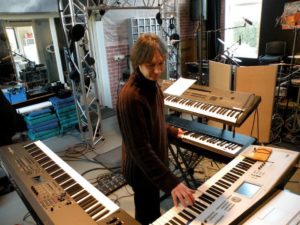 So I’d just encourage people to dive in and have a go. There are hundreds of Youtube videos that people have posted if you get stuck on something. Once you’ve learned the basics of how to record a sound, you can gradually increase your knowledge on other technical aspects of recording, should you need to – such as compression, editing, effects, equalisation, midi, mixing etc, etc.
So I’d just encourage people to dive in and have a go. There are hundreds of Youtube videos that people have posted if you get stuck on something. Once you’ve learned the basics of how to record a sound, you can gradually increase your knowledge on other technical aspects of recording, should you need to – such as compression, editing, effects, equalisation, midi, mixing etc, etc.
The other side of production is the whole relationship aspect. If you’re working with other musicians, it’s your job to get the best performance out of them and record it to the highest possible standard. I could write many pages on that! Then there is the relationship with the artist that you’re producing, trying to birth their musical vision, managing wildly varying budgets etc.
Production in its fullest sense is a mixture of technical ability, combined with psychology and bookkeeping! It’s something I started doing in my early twenties, with low budget releases and demos, and I have to say I’m still learning in all of these areas!
Q: How has your career evolved with this technology? Your electronic sounds always feel rich and natural, and mix so well with acoustic instruments. How do you achieve that balance?
When I realised in my mid teens that I wanted to follow music as a vocation, there were lots of exciting developments happening with the technology of the time. Suddenly, with the emerging synthesiser technology, a whole new sound palette was opening up. Bands like Yes, Genesis, Gentle Giant, Pink Floyd, ELP and many others were incorporating these new textures into their music, as well as exploring longer-form compositions.
In Yes and Gentle Giant’s music, in particular, I could also hear these new sounds combined with traditional acoustic and electric instruments and voices. I was very inspired by Mike Oldfield’s album Tubular Bells, on which he became the whole musical ensemble, overdubbing many tracks to create beautiful, multi-layered textures. After hearing Tubular Bells, I knew that this is what I wanted to do. At the same time I was studying classical music and also discovering folk music, so I was developing a love for all these acoustic textures.
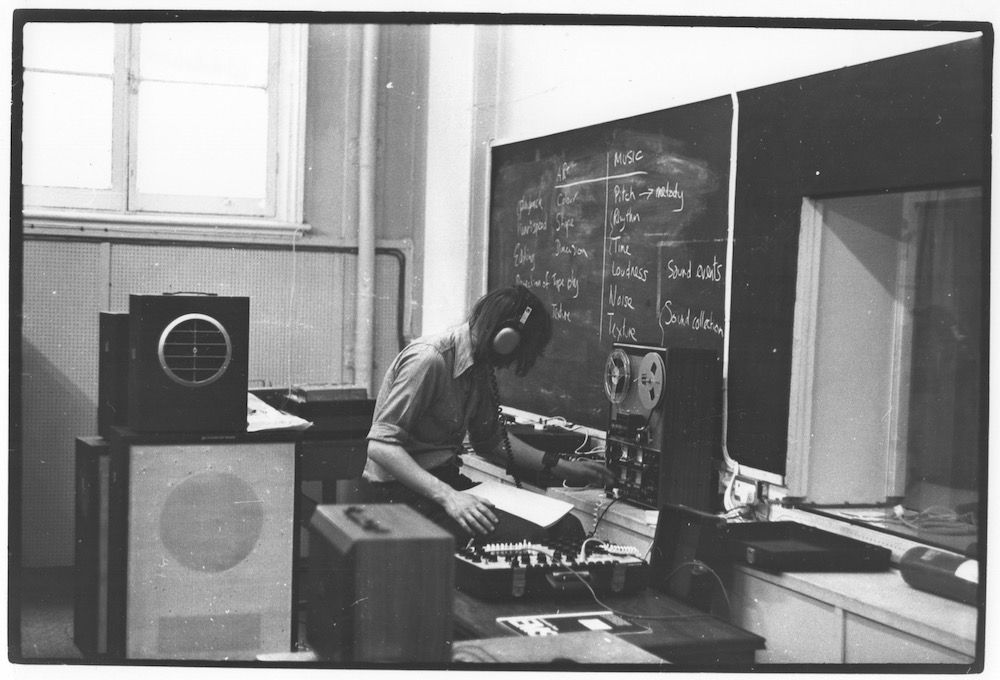
Dave Bainbridge at Leeds
When I got to music college, I quickly developed a deep interest in recording and electronic music, thanks to a great teacher called Pat Evans, who was a real musical maverick! He would combine acoustic and environmental sounds in his experimental pieces in a way I found very interesting and inspirational. He taught about the emotional impact of electronic sounds, which was very valuable to me in my future work.
I played synthesiser (one of four synth players!) in his Hyperspace Rock Ensemble, which was like a space age big band – great music! My early recorded compositions at college – even when I was 18 and 19 – were pieces which combined acoustic instruments with atmospheric sounds created on synthesisers. In a way, I’ve stuck to that template in much of the music I’ve subsequently written.
Q: Beautiful! And another aspect of technology: how has the internet helped you create new audiences for your music?
It has been good to connect with many individuals, groups, and websites who are broadly into the same kind of music, and to develop great and lasting relationships with reviewers, radio DJs, etc.
Over the years we’ve sent out many promo copies of albums and it is good to know that the people you’re sending them to will actually review and/or play them on their websites/shows, rather than them being lost in the ether! That’s certainly been a process of trial and error!
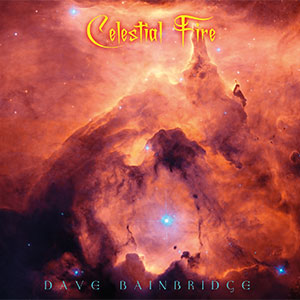 Creating a sizeable mailing list has been a crucial means of staying in touch with the audience. With other aspects, I’m still in a learning curve – I’m constantly frustrated by the ways in which Facebook filters your posts, so that those deemed to be advertising only get to a fraction of your friends.
Creating a sizeable mailing list has been a crucial means of staying in touch with the audience. With other aspects, I’m still in a learning curve – I’m constantly frustrated by the ways in which Facebook filters your posts, so that those deemed to be advertising only get to a fraction of your friends.
It was amazing when the Indiegogo campaign to record my second solo album “Celestial Fire” raised almost £20,000 ($25,000) back in 2013. It just showed how a core of only six or seven hundred people can make such a difference to your viability as an independent artist.
Relationships are so important and it’s great when you go out on tour to different countries and actually meet the people who’ve been supporting your music, who have previously just been friends in the “virtual” sense!
Yes, Dave, it really is all about relationships! Thank you so much for sharing your compositional process – I’m hoping to try out those conceptual, whittling down techniques with my next project. And I look forward to talking with you more next time about your own music and your fantastic career.
Until our next talk with Dave, his beautiful music on his website and Facebook page will inspire your own creation. Go ahead and try the big-picture planning strategies inspired by prog-rock master Dave Bainbridge. You may surprise yourself with the large scope of your musical vision.

